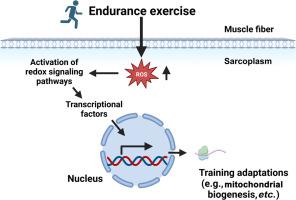当前位置:
X-MOL 学术
›
J. Sport Health Sci.
›
论文详情
Our official English website, www.x-mol.net, welcomes your
feedback! (Note: you will need to create a separate account there.)
Reactive oxygen species promote endurance exercise-induced adaptations in skeletal muscles
Journal of Sport and Health Science ( IF 9.7 ) Pub Date : 2024-05-07 , DOI: 10.1016/j.jshs.2024.05.001 Scott K Powers 1 , Zsolt Radak 2 , Li Li Ji 3 , Malcolm Jackson 4
Journal of Sport and Health Science ( IF 9.7 ) Pub Date : 2024-05-07 , DOI: 10.1016/j.jshs.2024.05.001 Scott K Powers 1 , Zsolt Radak 2 , Li Li Ji 3 , Malcolm Jackson 4
Affiliation

|
The discovery that contracting skeletal muscle generates reactive oxygen species (ROS) was first reported over 40 years ago. The prevailing view in the 1980s was that exercise-induced ROS production promotes oxidation of proteins and lipids resulting in muscle damage. However, a paradigm shift occurred in the 1990s as growing research revealed that ROS are signaling molecules, capable of activating transcriptional activators/coactivators and promoting exercise-induced muscle adaptation. Growing evidence supports the notion that reduction-oxidation (redox) signaling pathways play an important role in the muscle remodeling that occurs in response to endurance exercise training. This review examines the specific role that redox signaling plays in this endurance exercise-induced skeletal muscle adaptation. We begin with a discussion of the primary sites of ROS production in contracting muscle fibers followed by a summary of the antioxidant enzymes involved in the regulation of ROS levels in the cell. We then discuss which redox-sensitive signaling pathways promote endurance exercise-induced muscle adaptation and debate the strength of the evidence supporting the notion that redox signaling plays an essential role in muscle adaptation to endurance exercise training. In hopes of stimulating future research, we highlight several important unanswered questions in this field.
中文翻译:

活性氧促进骨骼肌耐力运动引起的适应
40 多年前首次报道了收缩骨骼肌会产生活性氧 (ROS) 的发现。 20 世纪 80 年代的流行观点是,运动引起的 ROS 产生会促进蛋白质和脂质的氧化,从而导致肌肉损伤。然而,随着越来越多的研究表明 ROS 是信号分子,能够激活转录激活剂/共激活剂并促进运动诱导的肌肉适应,20 世纪 90 年代发生了范式转变。越来越多的证据支持这样的观点:氧化还原(redox)信号通路在响应耐力运动训练而发生的肌肉重塑中发挥着重要作用。这篇综述探讨了氧化还原信号在耐力运动诱导的骨骼肌适应中所起的具体作用。我们首先讨论收缩肌纤维中 ROS 产生的主要位点,然后总结参与调节细胞中 ROS 水平的抗氧化酶。然后,我们讨论哪些氧化还原敏感信号通路促进耐力运动引起的肌肉适应,并讨论支持氧化还原信号在肌肉适应耐力运动训练中发挥重要作用这一观点的证据的强度。为了刺激未来的研究,我们强调了该领域的几个重要的尚未解答的问题。
更新日期:2024-05-07
中文翻译:

活性氧促进骨骼肌耐力运动引起的适应
40 多年前首次报道了收缩骨骼肌会产生活性氧 (ROS) 的发现。 20 世纪 80 年代的流行观点是,运动引起的 ROS 产生会促进蛋白质和脂质的氧化,从而导致肌肉损伤。然而,随着越来越多的研究表明 ROS 是信号分子,能够激活转录激活剂/共激活剂并促进运动诱导的肌肉适应,20 世纪 90 年代发生了范式转变。越来越多的证据支持这样的观点:氧化还原(redox)信号通路在响应耐力运动训练而发生的肌肉重塑中发挥着重要作用。这篇综述探讨了氧化还原信号在耐力运动诱导的骨骼肌适应中所起的具体作用。我们首先讨论收缩肌纤维中 ROS 产生的主要位点,然后总结参与调节细胞中 ROS 水平的抗氧化酶。然后,我们讨论哪些氧化还原敏感信号通路促进耐力运动引起的肌肉适应,并讨论支持氧化还原信号在肌肉适应耐力运动训练中发挥重要作用这一观点的证据的强度。为了刺激未来的研究,我们强调了该领域的几个重要的尚未解答的问题。


















































 京公网安备 11010802027423号
京公网安备 11010802027423号